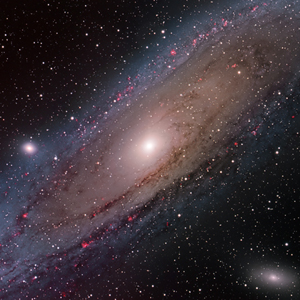 Fifty years ago a young astronomer named Frank Drake turned a radio telescope on a nearby star and listened for a message from an alien civilisation. Thus began the Search for Extraterrestrial Intelligence, or SETI. Apart from a few intriguing oddities, however, all that has greeted the astronomers since then has been an eerie silence. I have been associated with the theoretical aspects of SETI for many years, and I currently chair the SETI Post-Detection Taskgroup, charged with formulating a policy should the Big Day (i.e. contact with aliens) arrive.
Fifty years ago a young astronomer named Frank Drake turned a radio telescope on a nearby star and listened for a message from an alien civilisation. Thus began the Search for Extraterrestrial Intelligence, or SETI. Apart from a few intriguing oddities, however, all that has greeted the astronomers since then has been an eerie silence. I have been associated with the theoretical aspects of SETI for many years, and I currently chair the SETI Post-Detection Taskgroup, charged with formulating a policy should the Big Day (i.e. contact with aliens) arrive.
A good way of understanding what SETI has been doing this past half century is to look at a mathematical equation developed by Drake to guide SETI research. The “Drake Equation”, developed by Frank in 1961, gathers together the various factors that collectively determine the expected number of communicating civilisations existing elsewhere in our galaxy at this time. It is not so much an equation in the conventional mathematical sense, more of a way to quantify our ignorance.
N = R* x fp x ne x fl x fi x fc x L
The number N on the left-hand side of the equation represents how many “radio-active” civilisations are out there in the galaxy. Because SETI focuses on radio signalling, what counts as a communicating civilisation for the purpose of the Drake equation is simply one that possesses radio technology. There might be better ways to send signals across space, or there might be advanced alien civilisations that prefer not to engage in long-range communication, by radio or otherwise. But if there are, we won’t spot them using radio telescopes.
The symbols on the right-hand side of Drake’s equation are quantities we need in order to estimate – guesstimate would be more apt – the number N. Let me discuss each of them in turn.
The first term, R*, is the rate of sun-like stars being born per year in our galaxy. Why just in our galaxy? The reason is that receiving radio signals from beyond the Milky Way looks extremely unlikely, given the greater distances involved, although it is certainly not impossible. Anyway, let’s go with the restriction for now. The accumulated total number of sun-like stars in the galaxy today is known quite well to astronomers (by simply pointing a telescope and counting, then scaling up using simple statistics). The answer is around 10 billion, depending a bit on just how “sun-like” a star really needs to be to support life. But the number isn’t fixed: stars are born and stars die, and so it has been since the Milky Way began forming about 13 billion years ago. For example, about seven new stars a year are currently being added to the Milky Way on average, though that number has changed somewhat over the course of galactic history. The specifics don’t matter. The point is that the uncertainty in the value of R* is relatively small.
The next symbol, fp, is the fraction of those stars that have planets. Back in 1960 when SETI began, this quantity was unclear because nobody could be sure how planets form. One theory suggested the solar system was made from material dragged off the sun by a passing star – surely a very rare occurrence, implying that fp would be exceedingly small. Another theory supposed that the planets were made from matter concentrated in a disk or nebula of gas and dust swirling around the proto-sun. Drake – ever the optimist – went with the latter theory, and estimated fp = 0.5, i.e. half of sun-like stars have planets. For decades there was little help from observation, but today astronomers are able to detect planets going around other stars. The observations indicate that the nebula theory is right and that most stars have planets of some sort. In fact, Drake might have slightly underestimated the number. Actually, the original Drake equation left out of account an entire class of planets, the importance of which has only recently been appreciated.
Theoretical analysis of planetary motion suggests that orbits can be destabilised by planets “ganging up”, resulting in objects being flung out of a star system altogether. As a result, there could be many “rogue planets” wandering the dark interstellar spaces, perhaps accompanied by a retinue of moons. Quite possibly our solar system started out with more than the eight (or nine) planets we see today, the rest being ejected. An enduring memory from my ’50s childhood is of the fortnightly BBC television fantasy The Lost Planet. It featured a journey in an atomic-powered spaceship to the wandering planet of Hesikos, which temporarily entered the solar system from deep space. Hesikos turned out to be inhabited by telepathic humanoids. It was certainly a riveting story for an eight-year-old, but the idea of a planet meandering “lost” through the galaxy struck me at the time as the weakest link in the narrative. Lo and behold, it seems not to be so daft after all. Some astronomers estimate that there could be billions of rogue planets adrift in the Milky Way, so the Drake equation needs modification to take them into account. Anyway, adding up both the tethered and loose planets suggests a tally of somewhere in the region of a trillion in our galaxy.
For life as we know it to arise, a planet has to be “Earth-like”. The factor ne in the Drake equation stands for the number of planets in a star system able to support life (i.e. “Earth-like” planets – hence the subscript “e”). Drake initially picked 2 for the value of ne, which is to say, an average of two Earth-like planets per planetary system. What do the observations show? In the case of the solar system, Earth and Mars would qualify. As far as extra-solar Earth-like planets are concerned, none has so far been discovered. But that should soon change when the results of the Kepler mission – a satellite launched in 2009 with the sensitivity to detect Earth-like planets around other stars – become available. Various more ambitious space-based planet-finding instruments are being planned, and it is possible we shall have acceptable images of other earths out to, say, 50 light years within a decade or two. Almost certainly there are many Earth-like planets in the galaxy, but putting a precise number to it is hard. Somewhere between one and ten per cent is my estimate of the fraction of planets in sun-like star systems that at least resemble Earth in their temperature, atmospheric pressure and surface gravity. That is lower than Drake’s original figure, but not drastically so, and still amounts to billions of Earth-like planets.
Next comes the really hard part. The factor fl is the number of Earthlike planets on which life arises. That number is hugely uncertain. SETI enthusiasts such as Frank Drake and Carl Sagan put fl = 1. In other words, they assumed that if a planet was like Earth, then life was bound to arise in due course. The Nobel Prize winning biologist Christian de Duve is so convinced that life has to arise on Earth-like planets he calls it a “cosmic imperative”. On the other hand, sceptics like Jacques Monod (also a Nobel Laureate), who argues that life is so unlikely given all the necessary conditions that it is very possible we are all alone, think fl should be very close to zero. For now, we are largely in the dark. The factor fi, being the fraction of planets with life on which intelligence evolves, is similarly disputed. Carl Sagan took the astonishingly optimistic value of 1, implying that intelligence is inevitable sooner or later, once life gets going. Originally, Drake assigned the slightly more conservative, yet still hopeful, figure of 0.01 for fi. I believe this number is highly uncertain, as is fc, the fraction of planets with intelligent life on which science and telecommunications develop.
The final factor in the Drake equation is the average lifetime of a communicating civilisation. To appreciate the significance of this, imagine a town in which each homeowner switches his lights on and off for ten seconds, just once, at a time of night chosen randomly for each dwelling. Now ask how likely it is that two houses in the town will be lit up at the same time. If there are only a hundred houses in the town, chances are that no two houses will be illuminated together. Lights will come on and go off, randomly across the town, but probably never simultaneously. If the lights get left on for a minute rather than ten seconds, or if there are 10,000 houses in the town rather than a mere 100, then there is obviously a better chance of simultaneous illumination. Now think of communicating civilisations that way. They come and they go; they “light up”, then fade away. Right now, human civilisation is “lit up”. We’d like to know whether anyone else in the galaxy is going through their radio communication phase now. It’s no help when pursuing SETI radio searches to know that thousands of communicating civilisations may have come into existence in the Milky Way, but have long ago vanished, their transmissions ceased, or that thousands more will arise in the far future when humanity may have gone. The goal of traditional SETI is to acquire some cosmic company at this epoch. And the probability of success hinges on the term L in the Drake equation, the length of time an average alien civilisation broadcasts radio signals. The bigger the value for L, the greater the chance that another civilisation is on the air at this time.
Back in 1961 Drake picked L = 10,000 years. Sagan, who was depressed about human stupidity in relation to nuclear war and environmental damage, thought 10,000 years might be a bit optimistic. Michael Shermer, Director of the Skeptics Society, estimated that human civilisations are inherently unstable and typically collapse after only a few hundred years. Some biologists have argued that the average lifetime of a mammalian species is a few million years, and this sets a quite general upper limit on the expected duration of our civilisation. Of course, nobody really knows.
Personally, I think all the arguments concerning L are naïve and irrelevant, especially the biological one. Darwinian evolution was already suspended with agriculture, and is now completely superseded with the advent of modern medicine, democratic rights, genetic engineering and biotechnology. Human civilisation might yet succumb to a natural catastrophe, such as an asteroid impact or a species-jumping killer pandemic, or as a result of manmade disasters like nuclear war. But there is certainly no inevitability of such a thing, and if we make it through the next few centuries, we could be set fair for the indefinite future. I see no reason why, once an advanced extraterrestrial civilisation is established, it shouldn’t endure for an extraordinary length of time – millions or tens of millions of years or more. So this is one term in the Drake equation where I am more optimistic than the pundits.
Of greater relevance to traditional radio SETI is the question of whether the electromagnetic footprint of a civilisation will also endure for an extraordinary length of time. Humanity has been broadcasting radio signals for about a century. Our most powerful emissions come from military radar. After that, it’s TV stations. In the early days of SETI, scientists predicted a relentless rise in radio traffic, as wealth and technology advanced. But what happened was quite the reverse.
First, point-to-point communications became dominated by low-power satellites directing their signals earthward. Second, the bulk of telecommunications shifted away from radio to buried optical fibres. If ET is monitoring our radio traffic, it will seem to have risen to a peak in the late 20th century and then begun to fade. In another 100 years, there may be no substantial radio output from Earth. (Radar might still be used, plus the occasional command to a space probe.) So unless an alien community has a deliberate policy of transmitting powerful radio signals, it is entirely possible that the galaxy is bustling with advanced civilisations yet has no detectable artificial radio signature. It has been estimated that if we built a radio telescope 100 kilometres (60 miles) in diameter, it would be so sensitive we could detect a TV station as far away as Sirius, so it wouldn’t matter whether ET were beaming messages directly at us or not. But if Sirius TV is delivered via cable, we’d be out of luck. Eavesdropping on an extraterrestrial civilisation on the premise that the aliens may still be using 1980s human technology is a hard sell.
Anyway, for what it’s worth, if Drake’s figure L = 10,000 is adopted, together with his current estimates for all the other factors in his eponymous equation, one obtains the bottom line result N = 10,000; that is, there should be 10,000 civilisations in the galaxy at this time capable of communicating with each other (and us) using radio technology. Which seems very exciting. Ten thousand extraterrestrial civilisations on the air right now! If we knew that for a fact, SETI would be an urgent priority. “Let’s find them!” everyone would say. But as I have explained, although many terms in Frank’s equation are known rather well, and one at least (L) was in my view seriously underestimated, the equation is utterly dominated by two factors about which we know almost nothing – fl, the fraction of Earth-like planets on which life emerges, and fi, the fraction of those on which intelligence evolves. In my view the former is much more problematic than the latter. If life gets going, intelligence is at least in with a chance. It could be that intelligence is, after all, wing-like rather than trunk-like; it’s not too incredible. But it’s entirely possible that life’s origin is so freakish it has happened only once, and we are it. At this time we have no scientific grounds for refuting this position. There is to date not a shred of evidence that “nature favours life”, that there is a “life principle” directing murky chemical soups towards the grandeur of biology. And since we haven’t a clue about how life actually emerged, we can’t even bracket fl by concocting optimistic and pessimistic numerical estimates. At this stage of the game, the fraction could be anything at all between 0 and 1.
The uncertainty in fl dominates all other factors in the Drake equation. That number could be anything at all. So how can we get a handle on it? My research in cosmology and astrobiology has convinced me that the time is ripe to broaden the search, and seek out not just radio signals but any signatures of intelligent activity in the cosmos, using all the sciences.
Fortunately there is a simple way to start, overlooked until now. If life starts up readily on Earth-like planets, as Drake and many other astrobiologists assert, then it should have started many times over right here on Earth. After all, no planet is more Earth-like than Earth itself. The conventional wisdom is that all life on Earth descended from a common ancestor, and is inter-related on a single tree of life. But how can we be sure? Has anybody ever looked on Earth for life, but not as we know it? It turns out they haven’t. Most terrestrial life is microbial, and scientists have barely scratched the surface of the microbial realm. Could it be that among the teeming billions of micro-organisms all around us are some that are so weird they represent a separate sample of life altogether, a different tree deriving from an independent genesis event? Might there be a sort of “shadow biosphere” comprising truly alien microbes lurking right under our noses? Fortunately, enough scientists have taken this idea seriously to start a hunt.
This is an edited extract from Paul Davies’ new book The Eerie Silence: Are We Alone in the Universe?, published this month by Allen Lane
Letters to the editor: send us your thoughts for our letter pages by email to editor@newhumanist.org.uk

